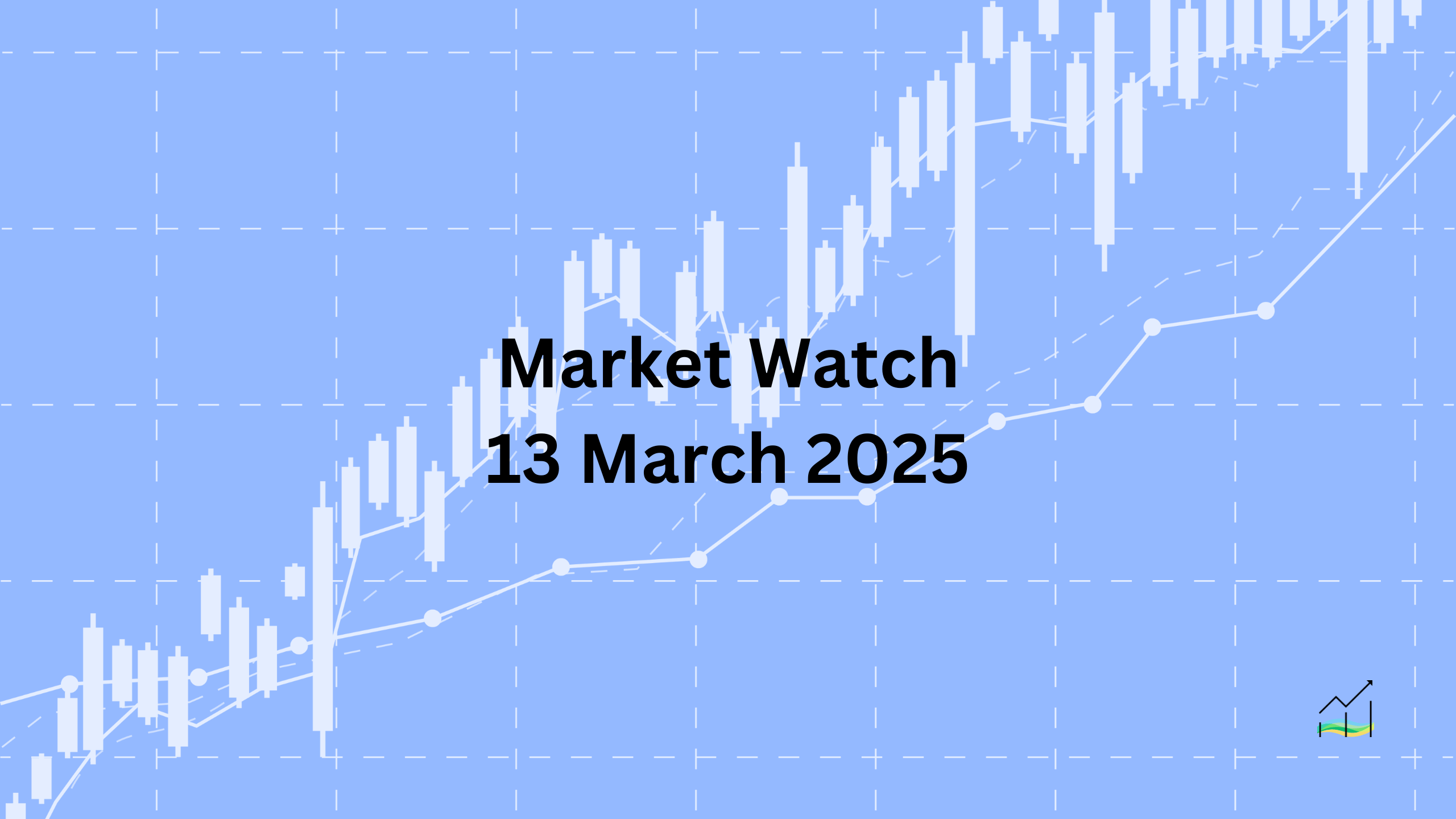13/03/2025 Market Watch

Dollar Holds Steady Amid Global Developments
The foreign exchange market remains relatively calm, with the dollar consolidating within previous ranges. Market activity has been subdued despite ongoing trade tensions, including US tariffs on steel and aluminum and retaliatory actions from the EU, Canada, and China. Additionally, diplomatic efforts are underway for a 30-day ceasefire in Ukraine, with US and Russian officials set to meet. Ahead of the talks, Russia has reported capturing a key town in Kursk. Meanwhile, political gridlock in the US threatens a partial government shutdown as Republicans struggle to secure Democratic support for the reconciliation bill.
Bond markets are experiencing mild pressure, with European benchmark 10-year yields rising by 2-3 basis points, pushing several countries’ yields to new highs. The US 10-year Treasury yield has edged up to approximately 4.33%. In the equity markets, Japan’s indices showed mixed performance, while major Asian stock markets declined. In Europe, the Stoxx 600 extended its gains after a four-day losing streak. However, US index futures are trending lower.
Commodities are showing notable movements. Gold is approaching last month’s record high, trading above $2,948 in late European morning turnover. Meanwhile, WTI crude oil briefly reached a four-day high of nearly $68 before retreating to around $67.25.
United States of America
Overview
The US Dollar Index is stabilizing after recent losses, trading within yesterday’s range. A push above the 104.25-104.40 zone could improve market sentiment after the index fell over 4% earlier this month. Inflation data remains in focus, with expectations that the Producer Price Index (PPI) will mirror the Consumer Price Index (CPI) decline. However, the Fed’s preferred measure, the PCE deflator, may not show the same trend. While no rate cuts are expected at the upcoming Federal Reserve meeting, investors will be closely watching the Summary of Economic Projections for guidance on future policy.
Economic Drivers
Several key factors are influencing market sentiment:
- Federal Reserve Policy: The Fed is expected to keep rates unchanged at 4.25%-4.50%. Futures indicate a year-end effective rate of 3.50%, the lowest since October.
- Stock Market Weakness: US equities have seen sharp losses, which may impact the economy through the wealth-effect channel.
- Inflation & Tariffs: Core goods prices are rising due to higher tariffs, while lower airfares suggest weakening consumer demand.
- Labor Market Concerns: Jobless claims are rising, pointing to a potential economic slowdown.
Data and Events
Recent economic reports provide further insight into market conditions:
- US Dollar Index – Fell to nearly 103.20 before stabilizing.
- Inflation Data – PPI expected to follow CPI’s downward trend, though PCE deflator remains uncertain.
- Fed Funds Rate – Target range of 4.25%-4.50%, with an effective rate around 4.33%.
- Stock Market Impact – Economic concerns grow as equity valuations decline.
- Labor Market Data – Jobless claims reached 221k for the week ending March 1, about 10k higher than a year ago.
Price Action
The dollar remains within a tight range, consolidating its position after recent losses. A breakout above 104.25-104.40 could shift momentum in favor of further strength. Meanwhile, expectations for a slower labor market and softer inflation continue to shape Fed policy expectations, keeping investors on edge.
Key Points:
- The US Dollar Index is stabilizing but needs to clear 104.25-104.40 for further recovery.
- Inflation data suggests some cooling, but the Fed’s PCE measure remains uncertain.
- No rate cut is expected at the upcoming FOMC meeting, but future guidance will be critical.
- Rising jobless claims and weaker equity markets could weigh on economic growth.
- Higher tariffs are pushing core goods prices higher, while falling airfares indicate slowing consumer demand.
Canada
Overview
The US dollar is trading within a narrow range against the Canadian dollar following the Bank of Canada’s widely expected rate cut. The greenback hit a session low near CAD1.4355 but has since stabilized within CAD1.4360-CAD1.4400. So far this year, the US dollar has averaged around CAD1.4350. The Bank of Canada’s policy outlook remains cautious, with concerns over economic uncertainty, particularly from the US. While another rate cut is expected around mid-year, market expectations for the next policy move have been downgraded, shifting focus to next week’s CPI data and the upcoming April 16 meeting.
Economic Drivers
Several factors are shaping the US-Canada exchange rate:
- Bank of Canada Rate Cuts: Two quarter-point cuts this year followed three 0.75% cuts in Q3 2024 and two 0.50% cuts in Q4 2024.
- Future Rate Expectations: Markets anticipate a terminal rate of 2.00%-2.25% with another possible cut later in 2025.
- US Economic Risks: Uncertainty from the US, particularly trade policies and tariffs, is influencing Canada’s economic outlook.
- Inflation and Growth Concerns: The Bank of Canada remains cautious, recognizing potential risks to both price stability and economic expansion.
Data and Events
Key developments impacting the market:
- US Dollar Movement – Traded within CAD1.4360-CAD1.4400 after touching a session low of CAD1.4355.
- Bank of Canada Rate Cut – Second quarter-point cut this year, following aggressive easing in 2024.
- Market Rate Expectations – Swaps indicate another rate cut around mid-year and a possible cut in the second half of 2025.
- Bank of Canada Policy Outlook – Concerns over US-driven risks could lead to a cautious stance.
- April 16 Meeting Outlook – Market expectations for a rate cut have weakened, shifting focus to inflation data.
Price Action
The US dollar is consolidating against the Canadian dollar following the rate decision, showing little volatility. Markets are adjusting to the central bank’s cautious approach, with expectations for further cuts later in the year. Upcoming CPI data and US trade developments may play a crucial role in determining future moves.
Key Points:
- The US dollar remains steady after the Bank of Canada’s latest rate cut.
- The Bank of Canada has delivered two rate cuts this year after aggressive easing in 2024.
- Markets expect a terminal rate between 2.00%-2.25%, with another cut likely in mid to late 2025.
- Economic uncertainty from the US is influencing Canada’s policy outlook.
- Focus shifts to next week’s CPI and the April 16 Bank of Canada meeting.
China
Overview
The US dollar rebounded sharply against the yuan after hitting a four-month low near CNH7.2160, climbing back to CNH7.25. The People’s Bank of China (PBOC) set the dollar’s reference rate at CNY7.1728, slightly higher than the previous day. Market focus remains on US-China trade tensions, with the US increasing tariffs on Chinese goods by 20% and extending them to Hong Kong for the first time. Meanwhile, China’s exports to the US surged to $76 billion in the first two months of the year, the highest in three years, as businesses moved to get ahead of the tariff hikes. Despite these pressures, the PBOC has maintained a relatively stable exchange rate.
Economic Drivers
Several key factors are shaping the US-China currency and trade dynamics:
- US Tariffs on China: A 20% tariff increase on Chinese goods now includes Hong Kong.
- China’s Export Surge: Chinese exports to the US reached $76 billion in Jan-Feb, the highest in three years.
- Stock Market Performance: The Hang Seng Index is up 18.5% this year, while mainland Chinese shares trading in Hong Kong have gained 20%.
- Technological Competition: The launch of DeepSeek and other AI advancements highlights China’s resilience despite US restrictions.
- Stable Exchange Rate Policy: The PBOC continues to manage the yuan within a narrow range, maintaining market stability.
Data and Events
Key developments influencing market movements:
- Tariff Impact on Trade – US raised tariffs by 20%, covering Hong Kong for the first time.
- China’s Export Growth – US-bound exports surged in early 2024 to preempt trade restrictions.
- AI and Technology Developments – China's advancements in AI signal its ability to compete despite US efforts to curb its growth.
Price Action
The yuan remains under pressure as the dollar continues its rebound, holding just below CNH7.25. Investors are monitoring trade tensions and policy responses, with China's stable exchange rate strategy helping to maintain confidence in the market. Meanwhile, stock market gains in Hong Kong and mainland Chinese equities reflect investor optimism despite geopolitical uncertainty.
Key Points:
- The US dollar recovered from a four-month low, stabilizing near CNH7.25.
- The US raised tariffs on Chinese goods by 20% and included Hong Kong.
- China's exports to the US surged to $76 billion in early 2024, the highest in three years.
- The Hang Seng Index is up 18.5% this year, with mainland shares in Hong Kong rising 20%.
- China continues to advance in AI and technology despite US trade restrictions.
- The PBOC maintains a stable exchange rate policy to support economic stability.
Europe
Overview
The euro’s recent rally slowed after briefly reaching $1.0950, slightly above the US election day high of $1.0935. It continues to trade within Tuesday’s range of $1.0830-$1.0950, with a low of around $1.0875 today. Since the end of February, the euro has gained approximately 5.6%, making momentum traders vulnerable to a pullback. Despite a decline in January’s eurozone industrial production, upcoming fiscal support and shifting risk sentiment could influence future trends. Next week’s ZEW survey may provide insight into evolving market expectations.
Economic Drivers
Key factors influencing the euro’s movement:
- Recent Rally & Resistance: After a 5.6% surge since late February, momentum is slowing, with resistance near $1.0950.
- Eurozone Industrial Data: January industrial production declined by 0.8%, though the impact is limited due to anticipated fiscal support.
- Upcoming Risk Sentiment Shift: The March ZEW survey could reflect a changing market outlook.
- Political Dynamics in Germany: Previous concerns about securing agreement on defense spending and the debt brake may have been overstated, with shifting political stances among the German Greens.
Data and Events
Recent market developments impacting the euro:
- Recent Eurozone Data – Industrial production fell by 0.8% in January, but its influence is limited.
- Momentum & Market Positioning – The strong 5.6% rally since February could lead to short-term corrections.
- Political Developments in Germany – Changing views among policymakers may ease concerns over fiscal policies.
- Upcoming ZEW Survey – March data may highlight shifting risk sentiment in the eurozone.
Price Action
The euro remains within Tuesday’s trading range, consolidating after its recent rally. While momentum traders may face short-term volatility, overall sentiment remains cautious. Upcoming economic data and political shifts in Germany will likely influence further price movement.
Key Points:
- The euro stalled after touching $1.0950, holding within Tuesday’s range.
- It has gained 5.6% since late February, making a pullback possible.
- January eurozone industrial production declined by 0.8%, but upcoming fiscal support limits its impact.
- The German Greens’ stance on economic policies may reduce previous political concerns.
- The March ZEW survey could provide insight into shifting market sentiment.
Japan
Overview
The US dollar has partially recovered after falling from JPY151.30 on March 3 to JPY146.55 on March 11, rebounding to around JPY148.90. The next key resistance is near JPY149.50, aligning with the 61.8% retracement level and the 20-day moving average, which the dollar has not closed above since mid-January. Today, it is trading on the softer side, remaining near the lower end of yesterday’s range, with a low of JPY147.60. Japan’s recent economic data has fallen short of expectations, adding to market uncertainty.
Economic Drivers
Several factors are influencing the yen’s movement:
- Dollar Recovery: The US dollar has regained half of its recent losses, with resistance at JPY149.50.
- Weak Wage Growth: January wage data came in lower than expected, with December’s figures revised downward.
- Declining Household Spending: Japan’s household spending dropped by 0.8% year-over-year, far below the 3.7% forecast.
- Slower GDP Growth: Q4 GDP was revised down to 2.2% from 2.8%, contrary to expectations of no revision.
- BOJ Interest Rate Outlook: The Bank of Japan’s target rate remains at 0.50%, with market expectations for a year-end rate of 0.80%, down 14 basis points from earlier this month.
Data and Events
Key developments affecting market sentiment:
- Wage Data Disappoints – January wage growth came in lower than expected, and December’s figures were revised down.
- Household Spending Drop – Japan’s household spending contracted 0.8% year-over-year, well below estimates.
- GDP Revision – Q4 GDP was revised down from 2.8% to 2.2%, missing expectations.
- BOJ Policy Outlook – The market now expects a year-end policy rate of 0.80%, down from previous forecasts.
Price Action
The dollar remains under pressure but has regained some ground against the yen. It is consolidating in the lower end of yesterday’s range, with resistance near JPY149.50. The yen’s weakness is driven by disappointing economic data, while traders are closely watching the Bank of Japan’s policy trajectory and upcoming market catalysts.
Key Points:
- The dollar fell from JPY151.30 to JPY146.55 but has rebounded to JPY148.90.
- Key resistance is at JPY149.50, where the 61.8% retracement level and 20-day moving average align.
- Japan’s wage growth and household spending data were weaker than expected.
- Q4 GDP was revised down from 2.8% to 2.2%, missing forecasts.
- The BOJ’s target rate remains at 0.50%, with market expectations for 0.80% by year-end decreasing.
United Kingdom
Overview
The British pound briefly surged to nearly $1.2990, its highest level since November 8, before reversing lower toward $1.2915. Today, it remains in a narrow range of $1.2940-$1.2975, consolidating after a strong rally over the past five weeks. Meanwhile, the euro found support at GBP0.8400 and rebounded to GBP0.8430. Market focus is now on the upcoming UK GDP report, which is expected to show modest growth, along with key industrial and trade data.
Economic Drivers
Several factors are shaping sterling’s movement:
- Recent Rally & Resistance: Sterling has risen in four of the past five weeks, with resistance near $1.2990.
- UK GDP Expectations: January GDP is forecasted to grow by 0.1% after a 0.4% expansion in December.
- Industrial Output Slowdown: Expected to decline by 0.1% after a 0.5% increase in December.
- Services Sector Growth: Likely to slow to 0.1% from 0.4% in December.
- UK Trade Balance: Excluding precious metals, the trade deficit is expected to narrow to GBP2 billion from GBP2.27 billion.
Data and Events
Key economic updates influencing sterling:
- January GDP Forecast – Expected to show 0.1% growth, following December’s 0.4% expansion.
- Industrial Output Projection – Anticipated to decline by 0.1% after a strong 0.5% gain in December.
- Services Index Outlook – Growth expected to slow to 0.1% from 0.4% in December.
- Trade Balance Improvement – The deficit (excluding precious metals) is projected to narrow to GBP2 billion.
Price Action
Sterling remains within a tight range after pulling back from its recent high. A break above $1.2990 could signal further gains, while support near $1.2915 remains key. The euro’s recovery against the pound indicates a balancing of flows, with upcoming UK GDP data likely to drive the next move in currency markets.
Key Points:
- Sterling hit $1.2990, its highest since November, before pulling back to $1.2915.
- The pound has gained in four of the past five weeks, showing strong momentum.
- UK GDP is expected to grow by 0.1% in January, following 0.4% in December.
- Industrial production and services growth are projected to slow.
- The UK trade deficit (excluding precious metals) is expected to narrow to GBP2 billion.
- Market focus remains on upcoming GDP data, which could drive the next major move in sterling.
© 2025 SKONE Enterprise (003319453-V). All rights reserved.
The content on this site is for informational purposes only and does not constitute financial advice.


